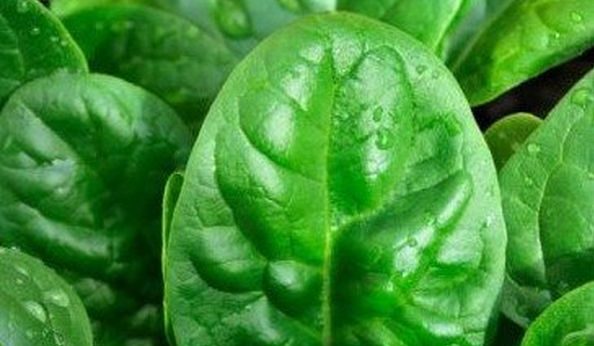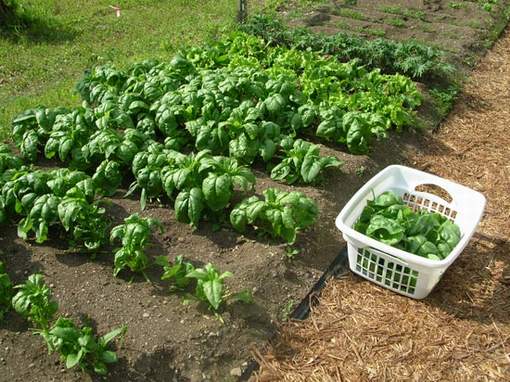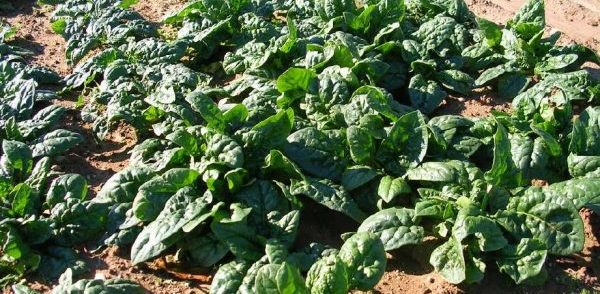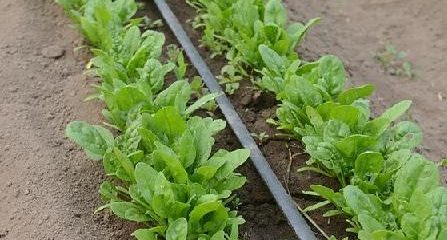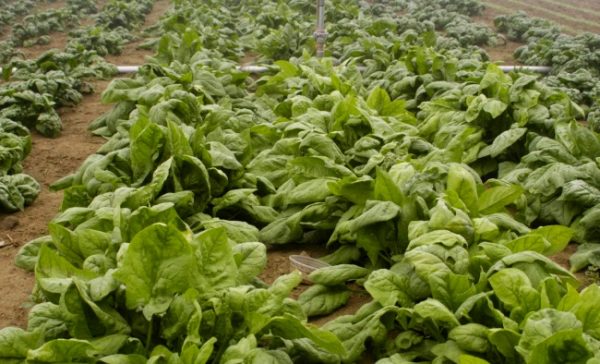How to grow vegetable spinach in your garden
Content
Botanical description
Garden spinach is an annual herbaceous plant, reaching a height of 50 cm. It belongs to the Amaranth family (formerly called Marevs). Its elongated leaves have different shapes and thicknesses, depending on the variety, they can be oval, triangular, smooth or wrinkled. As a dioecious culture forms male plants - with flowers gathered in a panicle, and female - flowers grow in the leaf axils.
Spinach flowers are cross-wind-pollinated, so only one variety must grow on the plot to produce seeds. In spring and autumn, he grows leaves (for the sake of which his cultivation is organized), and when daylight hours lengthens, peduncles grow, first on male, and then on female plants. In this case, the leaves lose their juiciness, oxalic acid begins to accumulate in them.
Young leaves (before flowering) are rich in vitamins: A, C, B, K, D, organic acids, protein. Garden spinach is recommended to be eaten in order to strengthen the immune system, get rid of vitamin deficiency and seasonal depression, strengthen blood vessels, whip up the activity of the gastrointestinal tract, and get rid of flatulence. Traditional medicine uses it to combat a number of nervous diseases, rickets and general weakness, constipation, anemia, diseases of the throat and respiratory tract, up to pneumonia. But it must be remembered that spinach casting is prone to the accumulation of nitrates, in addition, the organic salts that make up their composition will do a disservice to people whose internal organs form sand or stones. Elderly people should not get carried away with spinach (as well as sorrel), as it contains a large amount of oxalic acid, which threatens the formation of oxalates.
But such warnings in no way diminish the usefulness of this truly wonderful vegetable, its moderate consumption is only beneficial. Among the caveats, I would like to note one more thing: food prepared from spinach should be stored only in the cold and no more than a day. In the heat, any dish containing spinach can turn into poison, because nitrous acid compounds are formed, which contribute to the formation of methemoglobin.
Video "Growing spinach"
Demonstration video on how you can grow spinach on your site.
Growing
Growing spinach from seeds is widespread. For germination, an air temperature of +4 degrees is enough for them, the sprouts calmly tolerate short-term frosts. Its fall, if large winter frosts are not expected (in the south) or in spring after thawing of the earth. In the middle lane, sowing before winter and film coatings are usually used.When using a heated greenhouse, and even with backlighting, this crop can be grown anywhere. The seeds can be sown several times, it is convenient to grow it between cucumbers, eggplants, peppers or tomatoes.
Garden spinach grows well on nutritious fertile soil, it prefers loam and sandy loam, is sensitive to acidity levels. Cultivation is carried out at pH 6.6-7.0, more acidic soils are destructive for it. If the soils are heavy, then you need to apply organic fertilizers in advance.
In the garden, it is advisable to sow spinach where previously tomatoes, cucumbers, onions, potatoes, beans or cabbage were grown. In the fall, it is advisable to fertilize the soil with compost, humus, or you can apply complex fertilizers and ash. It must be borne in mind that an excess of potassium will accelerate the shooting, which means that the period of leaf growth will be shortened.
Spinach roots go deeper by 30 cm, they produce certain substances that have a beneficial effect on neighboring crops. Therefore, it is often planted among radishes, kohlrabi, celery, head lettuce. Strawberries grow and bear fruit well in such a neighborhood. So often summer residents do not set aside a separate plot for spinach, but plant seeds throughout the garden, which will improve the condition of the soil and help the above crops grow.
But, if the summer resident is interested in getting a rich crop of spinach, to grow it, you need to find a place protected from the north and east winds with well-drained fertile soil. In the fall, add compost or humus for digging. In the Non-Black Earth Region, in the spring, before sowing, complex mineral fertilizers are applied, but then they are fed only if absolutely necessary, because this vegetable is prone to the accumulation of nitrates.
To obtain an early harvest, seeds are sown in August, then before winter not only shoots will appear, but even the first rosettes will form. Then they are sheltered for the winter, and in the spring, after thawing the soil, they continue to grow. Before spring sowing, seeds are soaked in water for a couple of days to accelerate germination. Then they are dried until flowable and sown to a depth of 2 - 3 cm in rows, leaving 30 cm between them.When 2 true leaves appear, the spinach is thinned out, 8 - 10 cm are left between the plants. - the most productive.
Growing spinach means getting tender leaves, and if the plant is low on water, it will concentrate on growing the stem and preparing for flowering. Therefore, you need to monitor the humidity, water in a timely manner, if there is a need for fertilizing, then they are combined with watering. During the season, a bed with spinach is weeded several times, the ground between the plants is loosened.
If the bushes grow very often, they risk getting sick with downy mildew. The affected leaves must be removed, the plantings must be thinned out. Growing spinach in the same place is only possible after 3 years. This will protect the plants, help protect them from diseases and pests. Aphids, cabbage scoop, gamma scoop, or rather, their caterpillars are pests that may enjoy planting spinach. Caterpillars will have to be removed mechanically, and the plants will need to be treated with infusion of tobacco or tomato leaves, if necessary.
When growing spinach, gardening begins as soon as a rosette of 5 to 8 leaves is formed. Plants are cut or even mowed, sometimes uprooted. Harvesting stops when flower stalks begin to grow.
The harvested leaves can be stored for a week at a temperature of +1 degrees. If you need to prepare for future use, then the leaves are frozen, and at a temperature of -1 or -2 degrees they are stored for 3 months without loss of quality. They can also be dried or salted. You can get seeds from your plants.To do this, several specimens must be allowed to bloom and mature, but this is only useful when grown in a single variety plot, as cross-pollination can create uncontrolled hybrids.
Spinach varieties
When choosing a variety, it is imperative to pay attention to the ripening dates, only taking them into account can you plan the sowing time. For example, the early maturing variety "Virofle" spinach with a growing season of about 30 days quickly forms stems. Lightly corrugated leaves form a rosette with a diameter of 30 cm.
The "Godri" variety is also early maturing, the growing season lasts 30 - 37 days. It is cultivated both in the protected and in the open field. Moreover, in the garden it is sown in early spring and before winter. It forms a rosette up to 23 cm in diameter.
In spinach "Ipolinsky" (also early - 35 days), slightly bubbly oval leaves form a rosette from 12 to 50 cm in diameter. It is advised to preserve it. Grown in the spring in the garden or in the greenhouse. Of late-ripening varieties, Victoria is usually cultivated. The growing season is 37 - 40 days, the leaves form a small rosette - up to 19 cm in diameter, it is very good for spring sowing. In addition to the garden one, you can find New Zealand spinach seeds, but this is not a separate variety, but just another plant, it is also called Tetragonia. This is also a green vegetable crop with similar nutritional and taste qualities, but it belongs to a different family - the Khrustalnikovs.
Video "A set of useful properties in one plant"
An informative video that proves the beneficial properties of a green plant.

